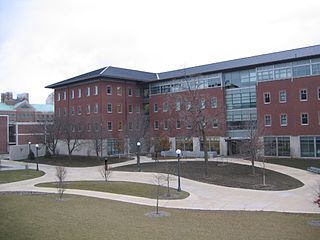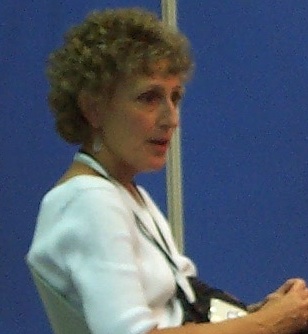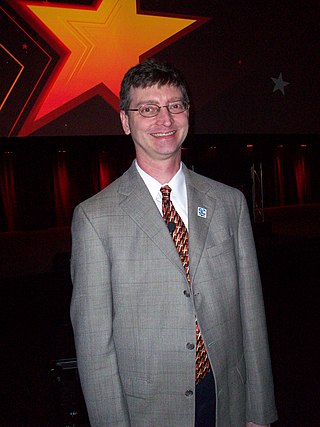The Association for Computing Machinery (ACM) is a US-based international learned society for computing. It was founded in 1947 and is the world's largest scientific and educational computing society. The ACM is a non-profit professional membership group, reporting nearly 110,000 student and professional members as of 2022. Its headquarters are in New York City.

The National Center for Supercomputing Applications (NCSA) is a state-federal partnership to develop and deploy national-scale cyberinfrastructure that advances research, science and engineering based in the United States. NCSA operates as a unit of the University of Illinois Urbana-Champaign, and provides high-performance computing resources to researchers across the country. Support for NCSA comes from the National Science Foundation, the state of Illinois, the University of Illinois, business and industry partners, and other federal agencies.
Grid computing is the use of widely distributed computer resources to reach a common goal. A computing grid can be thought of as a distributed system with non-interactive workloads that involve many files. Grid computing is distinguished from conventional high-performance computing systems such as cluster computing in that grid computers have each node set to perform a different task/application. Grid computers also tend to be more heterogeneous and geographically dispersed than cluster computers. Although a single grid can be dedicated to a particular application, commonly a grid is used for a variety of purposes. Grids are often constructed with general-purpose grid middleware software libraries. Grid sizes can be quite large.

Jack Joseph Dongarra is an American computer scientist and mathematician. He is a University Distinguished Professor Emeritus of Computer Science in the Electrical Engineering and Computer Science Department at the University of Tennessee. He holds the position of a Distinguished Research Staff member in the Computer Science and Mathematics Division at Oak Ridge National Laboratory, Turing Fellowship in the School of Mathematics at the University of Manchester, and is an adjunct professor and teacher in the Computer Science Department at Rice University. He served as a faculty fellow at the Texas A&M University Institute for Advanced Study (2014–2018). Dongarra is the founding director of the Innovative Computing Laboratory at the University of Tennessee. He was the recipient of the Turing Award in 2021.
Ian Tremere Foster is a New Zealand-American computer scientist. He is a distinguished fellow, senior scientist, and director of the Data Science and Learning division at Argonne National Laboratory, and a professor in the department of computer science at the University of Chicago.

David A. Bader is a Distinguished Professor and Director of the Institute for Data Science at the New Jersey Institute of Technology. Previously, he served as the Chair of the Georgia Institute of Technology School of Computational Science & Engineering, where he was also a founding professor, and the executive director of High-Performance Computing at the Georgia Tech College of Computing. In 2007, he was named the first director of the Sony Toshiba IBM Center of Competence for the Cell Processor at Georgia Tech.

TeraGrid was an e-Science grid computing infrastructure combining resources at eleven partner sites. The project started in 2001 and operated from 2004 through 2011.

Larry Lee Smarr is a physicist and leading pioneer in scientific computing, supercomputer applications, and Internet infrastructure. He is currently a Distinguished Professor Emeritus at the University of California, San Diego, and was the founding director of the California Institute for Telecommunications and Information Technology, as well as the Harry E. Gruber Endowed Chair Professor of Computer Science and Information Technologies at the Jacobs School of Engineering.
Thomas Albert "Tom" DeFanti is an American computer graphics researcher and pioneer. His work has ranged from early computer animation, to scientific visualization, virtual reality, and grid computing. He is a distinguished professor of Computer Science at the University of Illinois at Chicago, and a research scientist at the California Institute for Telecommunications and Information Technology (Calit2).
Metacomputing is all computing and computing-oriented activity which involves computing knowledge utilized for the research, development and application of different types of computing. It may also deal with numerous types of computing applications, such as: industry, business, management and human-related management. New emerging fields of metacomputing focus on the methodological and technological aspects of the development of large computer networks/grids, such as the Internet, intranet and other territorially distributed computer networks for special purposes.

The Open Grid Forum (OGF) is a community of users, developers, and vendors for standardization of grid computing. It was formed in 2006 in a merger of the Global Grid Forum and the Enterprise Grid Alliance. The OGF models its process on the Internet Engineering Task Force (IETF), and produces documents with many acronyms such as OGSA, OGSI, and JSDL.

Maxine D. Brown is an American computer scientist and retired director of the Electronic Visualization Laboratory (EVL) at the University of Illinois at Chicago (UIC). Along with Tom DeFanti and Bruce McCormick, she co-edited the 1987 NSF report, Visualization in Scientific Computing, which defined the field of scientific visualization.

William Douglas Gropp is the director of the National Center for Supercomputing Applications (NCSA) and the Thomas M. Siebel Chair in the Department of Computer Science at the University of Illinois at Urbana–Champaign. He is also the founding Director of the Parallel Computing Institute. Gropp helped to create the Message Passing Interface, also known as MPI, and the Portable, Extensible Toolkit for Scientific Computation, also known as PETSc.
Marc Snir is an Israeli-American computer scientist. He holds a Michael Faiman and Saburo Muroga Professorship in the Department of Computer Science at the University of Illinois at Urbana-Champaign. He currently pursues research in parallel computing. He was the principal investigator (PI) for the software of the petascale Blue Waters system and co-director of the Intel and Microsoft-funded Universal Parallel Computing Research Center (UPCRC).

The University of Illinois Department of Computer Science is the academic department encompassing the discipline of computer science at the University of Illinois Urbana-Champaign. According to U.S. News & World Report, both its undergraduate and graduate programs rank in the top five among American universities, and according to Computer Science Open Rankings, the department ranks equally high in placing Ph.D. students in tenure-track positions at top universities and winning best paper awards. The department also ranks in the top two among all universities for faculty submissions to reputable journals and academic conferences, as determined by CSRankings.org. From before its official founding in 1964 to today, the department's faculty members and alumni have contributed to projects including the ORDVAC, PLATO, Mosaic, JavaScript and LLVM, and have founded companies including Siebel Systems, Netscape, Mozilla, PayPal, Yelp, YouTube, and Malwarebytes.

Valerie Elaine Taylor is an American computer scientist who is the director of the Mathematics and Computer Science Division of Argonne National Laboratory in Illinois. Her research includes topics such as performance analysis, power analysis, and resiliency. She is known for her work on "Prophesy," described as "a database used to collect and analyze data to predict the performance on different applications on parallel systems."
Rick Stevens is a professor of computer science at the University of Chicago and associate laboratory director for Computing, Environment and Life Sciences (CELS) at Argonne National Laboratory.
Katarzyna Keahey is a Senior Computer Scientist at Argonne National Laboratory and the Consortium for Advanced Science and Engineering (CASE) of the University of Chicago. She is a Principal Investigator (PI) of the Chameleon project, which provides an innovative experimentation platform for computer science systems experiments. She created Nimbus, one of the first open source implementations of infrastructure-as-a-Service (IaaS), and co-founded the SoftwareX journal, publishing software as a scientific instrument.

Torsten Hoefler is a Professor of Computer Science at ETH Zurich and the Chief Architect for Machine Learning at the Swiss National Supercomputing Centre. Previously, he led the Advanced Application and User Support team at the Blue Waters Directorate of the National Center for Supercomputing Applications, and held an adjunct professor position at the Computer Science Department at the University of Illinois at Urbana Champaign. His expertise lies in large-scale parallel computing and high-performance computing systems. He focuses on applications in large-scale artificial intelligence as well as climate sciences.

Michael E. Papka is a Warren S. McCulloch professor of computer science at the University of Illinois Chicago. At Argonne National Laboratory, he works as a senior scientist, the deputy associate laboratory director for Computing, Environment, and Life Sciences (CELS), and the director of the Argonne Leadership Computing Facility. Additionally, Papka is the director of the Electronic Visualization Laboratory and co-director of the George Crabtree Institute for Discovery and Sustainability. Previously, Papka was a named Presidential Research, Scholarship and Artistry Professor at Northern Illinois University.












